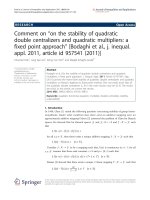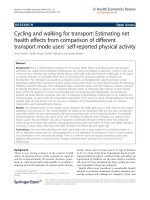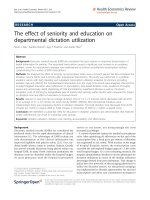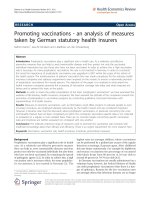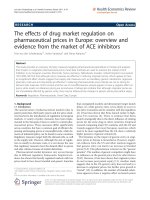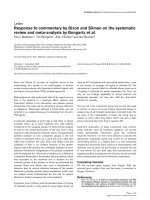Mohanraj et al 2022 review on sensor design for cutting force measurement
Bạn đang xem bản rút gọn của tài liệu. Xem và tải ngay bản đầy đủ của tài liệu tại đây (1.9 MB, 12 trang )
<span class="text_page_counter">Trang 1</span><div class="page_container" data-page="1">
Review on sensor design for cutting force measurement
The measurement of cutting force is one of the key factors in determining the tool condition and improving machine reliability. Therefore, the cutting force measurement becomes crucial to improve the machining process. The cutting force can be measured with piezoelectric as well as piezoresistive transducers. The force measuring transducers with later ones are cost-effective and can be easily installed in any small/medium-scale enterprise. For this approach, the selec-tion of sensing elements is essential. The various mechanical ring elements were used for sensing the deformaselec-tion. The low-cost device can be affordable in small-scale industries. Along with cutting force, it is suggested to measure the vibra-tion signals to analyze the machining dynamics of the process. The salient features and diverse force measuring trans-ducers were discussed in this article. This paper aims to briefly review the existing design and performance of dynamometers used in modern manufacturing.
Dynamometer, circular ring, octagonal ring, hexagonal ring, square ring, dial gauge, strain gauge <small>Date received: 21 December 2021; accepted: 13 May 2022</small>
The maintenance cost and timing in manufacturing indus-tries are raised, and productivity declines due to tool fail-ures.<sup>1</sup>The tool life was computed from the wear values of the previous experiments. Life remains functional, and tool-changing strategies are framed based on this tool. Overutilization or underutilization of cutting tools leads to loss of capital. Therefore, an effective tool condition monitoring system (TCMS) is essential to replace the tool at the right time and enhance productivity. The differ-ent sensors and signal processing techniques applied for the machining process were briefed in.<sup>2</sup> During the initial phase of cutting, the tool is sharp. Later, the mater-ial loss occurs due to high pressure and high temperature. The tool lost its sharp edge and increased the tool-workpiece contact area, and the material removal process became complicated. There is a need for a higher cutting force to remove the chip from the work-piece under the same cutting conditions.<sup>3</sup>
Moreover, with the increased tool-workpiece contact area resulting from tool wear, the same pressure generates more cutting force. During the machining process, the estimation of tool conditions is complicated. The indirect monitoring of tool conditions can be performed by measuring various signals like vibration,<sup>4,5</sup> cutting force,<sup>6–8</sup>acoustic emission signals,<sup>9–11</sup>spindle current,<sup>12</sup> temperature,<sup>12</sup> and cutting sound<sup>7</sup>during the machining
process.<sup>13</sup> Measurement of cutting force is one of the indirect methods used in TCMS<sup>14</sup> and has a significant role in TCMS.<sup>13</sup>
The cutting force has a massive influence on the gener-ation of heat, wear, dimensional accuracy of the compo-nent, and the surface roughness of the machined component.<sup>15,16</sup>During the turning with low feed values, it was noticed that cutting force increases with an increase inflank wear due to the losing of the cutting ability of tools.<sup>12</sup> When the number of passes increases, also tool wear increases, which is indicated by the cutting force value.<sup>17</sup>It is essential to understand the cutting force and its importance in optimizing the cutting parameters and ensuring the manufacturing of high-quality products at a low cost.<sup>18</sup> The cutting parameters for least cutting force, surface roughness, and tool wear were optimized.<sup>19</sup>
<small>Thangamuthu Mohanraj, Department of Mechanical Engineering, AmritaSchool of Engineering, Coimbatore, Amrita Vishwa Vidyapeetham, India.Email: </small>
<small>Proc IMechE Part E:</small>
<small>J Process Mechanical Engineering</small>
</div><span class="text_page_counter">Trang 2</span><div class="page_container" data-page="2">The previous work discussed the salient features and various force measuring transducers.<sup>20</sup>
The cutting force can be measured with the current sensor, capacitive, optoelectronic,<sup>21,22</sup> strain gauge, load cell,<sup>23</sup> flexure displacement,<small>24</small>
and piezoelectric sensor. The cutting force acted on the piezoelectric crystal produced the voltage proportional to the applied load. An amplifier circuit was used to amplify the voltage and then converted to force. Generally, piezoelectric sensors are responsive to mechanical force and have a wide bandwidth range of over 50 kHz. On the other hand, they are costly and require a sig-nificant concentration while installed in industry. Also, they are exposed to noise from nearby electrical drives.<sup>25</sup>
Force transducers use strain gauges to measure the strain when the sensing element is subjected to an external load.<sup>26</sup>Typically, ring element was considered a sensing element. The gauges are connected in the form of a Wheatstone bridge. While the applied load is zero, the bridge circuit is balanced, and the output voltage is zero. Once the transducer is subjected to loading, balan-cing of the bridge circuit is disturbed, and the voltage is a measure of applied load.<sup>20</sup> Recently, piezoceramic thickfilm sensor was used to measure the milling force.<small>27</small>
The numerous ring elements like circular ring,<sup>28,29</sup> diaphragm type,<sup>30</sup> elastic body,<sup>31</sup> bending beam,<sup>32,33</sup> hexagonal ring,<sup>34</sup> square ring,<sup>29</sup> modified square ring,<small>35</small>
octagonal ring,<sup>25,36–43</sup>two extended octagonal rings,<sup>44</sup> octag-onal–elliptical ring,<small>45</small>
eight-shaped elliptical ring,<sup>46</sup>and G & S-shaped ring<sup>47</sup>were used as a sensing element for force transducers. The review on cutting force measurement using different dynamometers is not published to the author’s knowledge. This paper will discuss the various sensing methods and dynamometer designs for cutting force measurement.
Strain gauge-based turning dynamometer
Strain gauge has been extensively used to measure the cutting force, owing to its simple construction, high reli-ability, and low cost. The first strain gauge-based tool holder dynamometer was designed to measure the turning force. The strain gauge sensors were fixed on the specific location of the tool holder with a bridge circuit to increase the sensitivity and decrease the cross-sensitivity. An IR module was used to transfer the data from the bridge circuit to the data acquisition system. Experimental results show that the dynamometer had a sensitivity of less than 0.24 mV/N.<sup>48</sup>The sensitivity was dependent on the design of the transducer.
A dynamometer using a strain gauge and piezoelectric accelerometer to measure the static and dynamic cutting forces in the turning process was designed. The designed dynamometer consists of an elastic element attached adequately with strain gauges, and Wheatstone bridge cir-cuits were established to measure the cutting force. The cutting force was measured with a 1.4% linearity error and 0.17–0.92% cross-sensitivity error during machining. The cross-sensitivity is mainly depending on the ring
element and the selection of placement of strain gauges. The locations of the strain gauge can be identified throughfinite element (FE) analysis.<small>49</small>
A Micro Electro Mechanical System (MEMS) strain gauge-based dynamometer was fabricated to capture the two-axis force during the turning process. An elastic element with two mutually perpendicular octagonal rings (TMPOR) was fixed to the cutting tool. The proposed MEMS sensor has optimized sensitivity and natural fre-quency. The TMPOR dynamometer sensitivity was 16 times higher than the conventional strain gauge-based dynamometer. The sensitivity and natural frequency of the developed dynamometer were 0.31 mV/N and 771 Hz, respectively. The strain gauge-based turning dynamometer is shown in Figure 1.<sup>50</sup>
A dynamometer with a high-performance sensor for the turning process was fabricated. TMPORs were used as a sensing element. Static calibration and impact tests show that the dynamometer had linearity of 83% and a natural fre-quency of 1122 Hz. The cross-sensitivity values were 2.5% to 10.5%. The higher value of cross-sensitivity is due to the misalignment of strain gauges on the TMPORs.<sup>51</sup> It is reduced by bonding the strain gauges in the appropriate location on the sensing element. The strain gauge-based tool holder dynamometer<sup>52</sup>was developed to measure the cutting force (1500 N) and torque (7.5 Nm) during the turning process. The FE analysis, calibration, and metro-logical characterization were not performed in this study.<sup>53</sup> A strain gauge-based tool holder dynamometer was designed to measure the cutting force (2000 N) during the turning process. After calibration, the actual machining test was conducted with the designed and Kistler 9257B dyna-mometer. The error percentage between the theoretical and experimental values was less than 5%.<sup>54</sup> This one-piece dynamometer can measure the cutting force after performing the calibration. The static and dynamic cutting force was mea-sured with a strain gauge and accelerometer<sup>55</sup>in an ultra-precision lathe. The machining test with different process parameters was directed to validate the performance of the designed dynamometer. The total cutting force was estimated by adding the static and dynamic components. The authors did not perform the metrological characterization.
A strain gauge-based high-capacity tool holder dyna-mometer was developed. The stiffness was reduced by adding the two holes symmetrically positioned about the axis. They found that this modification increased the sensitiv-ity.<sup>56</sup>A maximum cross-sensitivity of 4.5% was found in the Z-axis, and cross-sensitivity can be decreased by placing the strain gauges in the proper location. Shankar et al.<sup>57</sup>designed the dynamometer to measure the turning force in two axes. The static calibration result shows that the designed dyna-mometer had no hysteresis error. The machining test was carried out with a lathe, and the results were at par with the lathe tool dynamometer. They did not perform the dynamic calibration and metrological characterization.
A strain gauge-based novel dynamometer was designed for the turning process, and cutting parameters were optimized based on the measured cutting force.<sup>52</sup> The strain gauge-based turning dynamometer was
</div><span class="text_page_counter">Trang 3</span><div class="page_container" data-page="3">developed to measure the cutting force up to 2.9 kN with a natural frequency of 766 Hz. They found that sensitivities were 31.3× 10<small>−3</small>–172.4 × 10<small>−3</small>mV/N, and it had a low cross-sensitivity error of below 0.87%.<sup>58</sup>
Yaldiz and Unsacar<sup>59</sup> developed a dynamometer to measure the static and dynamic cutting force using a strain gauge and accelerometer. Four octagonal rings with strain gauges were used to measure the static force. The designed dynamometer measured the cutting force up to 3500 N with a sensitivity of± 5 N and cross-sensitivity of 0.17–0.92%. They suggested using this dynamometer to measure the cutting force in milling and drilling, and they have not per-formed any test for the milling and drilling process.
Current sensor-based cutting force measurement
Initially, Taylor proposed the current sensor-based cutting force measurement system by evaluating the motor
current of the machine tool. Since then, all over the world, the number of described initiatives to predict cutting force through current and power measurement has increased significantly. Figure 2 depicts the current sensor-based cutting force measurement system. The current signals consumed by the machine tool’s spindle motor are used to estimate the cutting force values.<sup>60–62</sup> The acceleration and current sensors measured the vibra-tion and spindle motor current to calculate the cutting force during the micro-end milling process.<sup>63</sup>
A dynamic model was proposed to calculate the cutting force from the spindle motor of a CNC machine tool. The proposed model gives the relationship between the cutting force and drives components.<sup>64</sup>Based on the feed drive control systems, a model was developed to analyze the current signals and estimate the cutting force to predict failures in the milling process. The feasi-bility of predicting the cutting force through armature current was discussed.<sup>65,66</sup> Hall effect sensor and
<small>Figure 1. Strain gauge-based turning dynamometer.</small>
</div><span class="text_page_counter">Trang 4</span><div class="page_container" data-page="4">control system model of a CNC lathe’s spindle and feed drive system were used to estimate the cutting force. The tangential and axial cutting force was predicted using an adaptive-neuro fuzzy inference system with 75% accuracy.<sup>67,68</sup>
The current of the spindle drive motor measured to estimate the cutting force is an alternate choice of an expensive dynamometer. The dynamics of the cutting force were measured using a mathematical model devel-oped with machining conditions and current signals. The maximum root-mean-squared error between the mea-sured and actual force was 25.99 N. The current signals had limited bandwidth and could not measure the dynam-ics of the cutting force.<sup>69</sup> The relationship between the
spindle motor current and the cutting force is complex. The frictional force between the feed table and guideways and the material properties of the workpiece lead to a vari-ation in motor current. Hence, it is challenging to charac-terize the relationship between current signals and the cutting force in the machining process.
Strain gauge-based milling dynamometer
In general, force transducers use dial gauges to measure the linear deflection up to a certain extent. Such transdu-cers can be used only for the continuous cutting process, not for intermediate cuttings. The dial-gauged force meas-uring instruments does not have consistent performance<small>Figure 2. Schematic representation of current sensor-based cutting force measurement.</small>
<small>Figure 3. Strain gauge-based octagonal ring dynamometer.</small>
</div><span class="text_page_counter">Trang 6</span><div class="page_container" data-page="6">over a while, and their stability studies were not encour-aging.<sup>70</sup>Hence, the strain gauges can measure the strain while applying the load. Kumar et al. developed the ring-shaped milling dynamometer with a strain gauge to measure the cutting force up to 50 N. The FE analysis was carried out to analyze the stress–strain pattern and deformation while applying the load. The location of maximum deformation was identified, and the strain gauge wasfixed on that location to sense the deformation of the ring element.<sup>28</sup>
The computation of stress, strain, and deformation was done based on ring theory,<sup>71</sup>and the results were matched with FE analysis. The metrological investigation analyzed the uncertainty due to zero offset, repeatability, reso-lution, interpolation, and reversibility. From the metro-logical analysis, the measurement of uncertainty was found as± 0.10%. They have not performed any machin-ing test, which can be used to confirm the accuracy of the dynamometer. Kumar et al. designed and developed the ring-shaped precision force transducer to measure 50 kN. After the metrological characterization, the uncer-tainty error was found as± 0.025%.<small>72,73</small>
The designed dynamometer was not undergone any actual machining test. They performed various investigations of force measurements.<sup>20</sup>
The circular ring-shaped sensing element was modified to square,<sup>35</sup>hexagonal, and octagonal rings.<sup>74</sup>This sug-gested modification significantly improves the net deflec-tion of the ring and the transducer’s sensitivity. Kumar et al.<sup>34</sup> compared the metrological performance of hex-agonal and octhex-agonal ring-shaped transducers with 20 kN capacity and measured the deformation using a dial gauge and strain gauge. The results show that the maximum uncertainty error for square, octagonal, and hexagonal rings was± 0.15%, ± 0.10%, and ± 0.09%, respectively. The hexagonal ring-shaped dynamometer performed better than the octagonal and square ring dynamometer. This design can be used to develop the dynamometer to measure the cutting force.
The strain gauge-based milling dynamometer was designed to assess the machining force up to 4500 N. The ring element dimensions were selected based on the ring theory. Totally 16 strain gauges were employed to measure the cutting force in three directions. The dynamom-eter was analyzed and found the natural frequency as 192.2 rev/s and cross-sensitivity as 0.05%.<sup>39</sup>They have not per-formed any metrological characterization or machining tests. Figure 3 shows a strain gauge-based octagonal ring dynamometer.<sup>19</sup>
The circle of the octagonal ring was changed to an ellipse to enhance the ratio of strain to displacement. The obtained results show that compared to the octagonal ring, the octagonal–elliptical ring maximizes the sensitiv-ity of about 15% and 26% in axial and tangential direc-tions, respectively. The FE analysis was used to detect the maximum stress/strain concentration, and strain gauges were bonded on the respective places. The cross-sensitivity error was less than 5%. After a metrological investigation, it was found that the overall uncertainty
</div><span class="text_page_counter">Trang 7</span><div class="page_container" data-page="7">was 1.78%.<sup>45</sup>The octagonal–ellipse ring design improves the sensitivity, and uncertainty error has to be reduced by proper calibration.
A multi-component dynamometer with an extended octagonal ring was designed and developed to measure the cutting force in the turning, milling, and drilling process. The vibration analysis was performed, and a machining test was conducted to ensure the reliability of the developed dynamometer.<sup>75</sup> The calibration and machining tests were not performed. The designed dyna-mometer measures the cutting force during any machining process. A drilling dynamometer with an extended octag-onal ring was developed with a sensitivity of± 5 N and a cross-sensitivity of 0.05%. The performance of the dyna-mometer was examined, and the results were consistent with theoretical calculations.<sup>76</sup>Table 1 gives a summary of various dynamometers for measuring the cutting force. The upcoming section describes the development of an octagonal ring-shaped dynamometer due to its better accuracy and sensitivity.
Steps in designing a dynamometer
The ring element has to be selected based on the applica-tion and range of measurement. The initial dimension of the ring element can be chosen based on the numerical modeling. The FE analysis is essential to estimate the ring’s deformation and stress values under the applied load. The design modification can be carried out based on the structural analysis. After that, the ring elements have to be machined as per the dimensions.
Construction of dynamometer
The critical component of dynamometer design is the sensing element. Piezoresistive MEMS sensors were used to measure the deformation. The strain gauges are attached to the ring where the maximum strain occurs. The location of maximum deformation has to be identified with FE analysis. The strain gauges must be attached based on the FEA results and ring theory. Before install-ing the strain gauges, the rinstall-ing element must be coated with Zinc oxide to avoid corrosion. The ring surfaces have
undergone a surface preparation process to achieve better accuracy. Later, appropriate adhesive glue was applied to attach the gauges to the ring, andfinally, the bridge circuit was designed to measure the cutting force.
Dynamic analysis
The natural frequency of the dynamometer must be four times larger than the exciting vibration frequency during the material removal process to eliminate the influence of machine tool vibration.<sup>39</sup>The dynamometer is viewed as a small mass supported by ring elements. Based on the dynamometer’s ring constant, the dynamometer’s natural frequency is computed. The stiffness of an elastic member is called a dynamometer ring constant. The stiff-ness of a thin circular ring was given by the following equa-tion<sup>71</sup>:
K<small>r</small>= <sup>Ebt</sup><sup>3</sup> 1.8r<small>3</small>
The natural frequency of the dynamometer, which is assumed as a small mass supported by ring elements, can be obtained from the following equation:
m—mass of the dynamometer (kg), f<small>d</small>—dynamometer’s natural frequency (Hz).
The impact test must be carried out to identify the natural frequency experimentally.
Data acquisition
After designing and developing the dynamometer, it has to be interfaced with the data acquisition system to acquire the cutting force during the machining process. Proper amplification and signal conditioning circuits must convert the strain/voltage signals into cutting force data. A computer connection must be established with a data acquisition system to acquire the cutting force and
<small>Figure 4. Schematic representation of data acquisition system.</small>
</div><span class="text_page_counter">Trang 8</span><div class="page_container" data-page="8">log into the computer. The strain signals are initially cap-tured from the strain gauge sensor and converted into voltage using the Wheatstone bridge circuit. The voltage signals are at millivolt level and unable to process further. Therefore, amplifier circuit is required to amplify the voltage level. After processing, the boosted voltage signals can be converted into appropriate cutting force and stored in the computer for more analysis. The typical representation of the data acquisition system is shown in Figure 4.
Piezoelectric material-based force sensors such as the Kistler dynamometer are widely used. It has good sensi-tivity, and machining dynamics can be easily measured. The drawback of the piezoelectric dynamometer is rigidity and requires recalibration due to regularly changing workpiece material and machining conditions.
Furthermore, the cost of the device is more and unable to afford in small- and medium-scale industries. Hence, the researchers’ interest is the strain gauge-based dyna-mometer with different designs of sensing elements. Therefore, various designs like square, hexagonal, octag-onal, S-shaped, and G-shaped rings were considered for FE analysis. The EN8 material is chosen for the FE ana-lysis. The base was fixed, and a load of 5000 N was applied at the center point. The responses were recorded and is shown in Table 2. On comparing the results, it is noticed that the eight-shaped ring with a circular hole has higher displacement for a given axial load. However, in the case of the eight-shaped rings with a cir-cular hole, they cannot withstand the applied shear force and reaches the yielding point. Therefore, the eight-shaped rings with an elliptical hole are chosen. The dimensions of the ring element can be finalized based on the stress values, and the induced stress value should be less than half of the yield strength to avoid yielding.
<small>Table 2. Results of comparison of different shapes when a normal load is applied.</small>
<small>Figure 5. Milling dynamometer with eight-shaped elliptical ring.</small>
</div><span class="text_page_counter">Trang 9</span><div class="page_container" data-page="9">This can be obtained by increasing the thickness of the material at the shear zone by modifying the circular ring into an elliptical ring element, as shown in Figure 5.<sup>46</sup>
During the fabrication of the ring element, the dimen-sional accuracy has to be appropriately maintained to enhance the performance. The essential characteristics are sensitivity, cross-sensitivity, accuracy, and linearity. The maximum sensitivity and minimum cross-sensitivity are crucial to the dynamometer. The elliptical design increases the strength of the ring element to withstand the shear load and increases the sensitivity of the ring. The sensitivity mainly depends on the deformation of the ring element. The cross-sensitivity can be minimized by bonding the sensor in the appropriate location by matching the sensor’s axes in both directions. The natural frequency of the dynamometer can be increased by increasing the stiffness of the ring element and by decreasing the mass of the ring element.
The metrological characterization has to be performed as per the ISO standard. The errors in measurements are unavoidable while performing the calibration tests. Therefore, uncertainty analysis is required to validate the accuracy of the designed dynamometer. An ISO 376:2011 standard procedure has to be followed for uncertainty analysis.<sup>29</sup> According to ISO 376-2011, six uncertainty components were considered.
It was found that an octagonal ring with an elliptical section performed better than an octagonal ring with a cir-cular section in terms of sensitivity and uncertainty values. The designed dynamometers are more suitable for measuring the cutting force components and cannot measure the cutting force’s dynamics. The dynamics of the cutting force have a significant role in TCMS. The dynamics can be analyzed using an accelerometer and a dynamometer in the future.
Challenges and future outlook
The selection of ring elements and their dimensions require significant attention to enhance the sensitivity. The sensitivity analysis is essential to confirm the dimen-sions of the ring element. The dimensional accuracy has to be maintained during the machining of rings. The loca-tion of strain gauges has to be marked clearly to reduce the cross-sensitivity error. Additional safety measures have to be incorporated to safeguard the sensor from the coolant. Proper calibration is required to design a signal condition-ing unit.
The designed dynamometers can be affordable in small- and medium-scale industries to measure the cutting force and develop TCMS. Moreover, the facil-ity to perform cloud computing or edge computing for supporting Industry 4.0 or digital manufacturing is a value addition. It can be accomplished through additional interfacing and connectivity (Wi-Fi, BlueTooth, etc.). It is helpful deploying the Industrial Internet of Things (IIOT) to enhance the effective machining process.
This paper reviews cutting force measurement using a strain gauge with various sensing elements. The different sensing methods and ring elements were used for measur-ing the cuttmeasur-ing force. Based on the discussion, the follow-ing results have arrived.
• The indirect measurement of cutting force seems to be low cost and reliable. Therefore, different types of ring elements have been used, and the results are consistent. • The deformation measured through the dial gauge is suitable for only a narrow range. For better measure-ments, strain gauges can be effectively used.
• Dynamometers can be designed with G- and S-shaped rings. However, they have a higher value of stress, which is not suitable for higher load.
• The circular ring element was suitable for low-load applications only.
• For higher precision measurement, modified ring elements can be used. The hexagonal and octagonal ring elements are most suitable for cutting force measurement.
• The octagonal–ellipse ring with MEMS-based sensors and proper location of sensors will be the better option to enhance the sensitivity of the dynamometer. • Additionally, the dynamics of the cutting force can be
analyzed through the measurement of vibration signals • The measurement of cutting force can be used to
monitor the tool condition in real time.
• The force measurement can be integrated with connect-ivity to push the data to the cloud and enable the intel-ligent manufacturing process.
Declaration of conflicting interests
<small>respect to the research, authorship, and/or publication of thisarticle.</small>
<small>authorship, and/or publication of this article.</small>
ORCID iDs
<small>1. Dimla DE. Sensor signals for tool-wear monitoring in metal</small>
<small>review on sensors and signal processing systems in mechan-ical machining processes. Int J Adv Manuf Technol 2021;</small>
<small>indir-ect tool condition monitoring systems and decision-making</small>
</div><span class="text_page_counter">Trang 10</span><div class="page_container" data-page="10"><small>methods in turning: critical analysis and trends. Sensors2020; 21: 108.</small>
<small>4. Mohanraj T, Shankar S, Rajasekar R, et al. Tool conditionmonitoring in the milling process with vegetable based</small>
<small>5. Krishnakumar P, Rameshkumar K and Ramachandran K.</small>
<small>acoustic emission and vibration data in high speed millingprocess using wavelet features. Intell Decis Technol 2018;</small>
<small>6. Shankar S, Mohanraj T and Rajasekar R. Prediction of</small>
<small>intelligence techniques. Int J Computer Integr Manuf</small>
<small>7. Shankar S, Mohanraj T and Pramanik A. Tool condition </small>
<small>8. Niaki FA, Ulutan D and Mears L. Stochastic tool wear</small>
<small>9. Rameshkumar K, Mouli D and Shivith K. Machine learningmodels for predicting grinding wheel conditions usingacoustic emission features. SAE I J Mater Manuf 2021;</small>
<small>10. Shivith K and Rameshkumar K. AE Signature analysis usingcontinuous and discrete wavelet transforms to predict grind-ing wheel conditions. In: Nor Azlan Othman (Ed.) IOPconference series: materials science and engineering.Singapore: IOP Publishing, 2021, p.012034.</small>
<small>11. Mouli D and Rameshkumar K. Acoustic emission-basedgrinding wheel condition monitoring using decision tree</small>
<small>Chakrabarty, S and Mishra P (eds) Advances in materialsand manufacturing engineering. Singapore: Springer,</small>
<small>beha-viors for sensor fusion with tool condition monitoringsystem in turning. Measurement 2021; 173: 108582.13. Mohanraj T, Shankar S, Rajasekar R, et al. Tool condition</small>
<small>14. Balazinski M, Czogala E, Jemielniak K, et al. Tool </small>
<small>15. Luis N, Lamikiz A and Sanchez J. Simultaneous measure-ment of forces and machine tool position for diagnostic of</small>
<small>16. Seguy S, Campa FJ, Lopez de Lacalle LN, et al. Toolpathdependent stability lobes for the milling of thin-walled</small>
<small>tool wear for determining of optimized machining </small>
<small>18. Segonds S, Landon Y, Monies F, et al. Method for rapidcharacterisation of cutting forces in end milling considering</small>
<small>19. Shankar S, Mohanraj T and Thangarasu SK. Multi-responsemilling process optimization using the taguchi methodcoupled to grey relational analysis. Mater Test 2016; 58:</small>
<small>20. Kumar H, Sharma C, Kumar A, et al. Retrospective </small>
<small>21. Sandwell A, Lee J, Park C, et al. Novel multi-degrees offreedom optical table dynamometer for force measurements.Sens Actuators, A 2020; 303: 111688.</small>
<small>22. Subasi O, Yazgi SG and Lazoglu I. A novel triaxial optoe-lectronic based dynamometer for machining processes. Sens</small>
<small>23. Lapsomthop W, Wongsirirax N, kititeerakol A, et al. Design</small>
<small>sensor in mini CNC milling machine. Mater Today Proc</small>
<small>24. Gomez MF and Schmitz TL. Displacement-based dyna-mometer for milling force measurement. Procedia Manuf</small>
<small>25. Soliman E. Performance analysis of octal rings as </small>
<small>26. Tavakolpour-Saleh AR and Sadeghzadeh MR Design anddevelopment of a three-component force/moment sensorfor underwater hydrodynamic tests. Sens Actuators, A</small>
<small>27. Drossel W-G, Gebhardt S, Bucht A, et al. Performance of a</small>
<small>control of cutting forces during milling. CIRP Ann 2018;</small>
<small>28. Kumar H, Sharma C, Kumar A, et al. Design, developmentand metrological characterization of a low capacityprecision industrial force transducer. ISA Trans 2015; 58:</small>
<small>29. Kumar H, Sharma C and Kumar A. The development andcharacterization of a square ring shaped force transducer.Meas Sci Technol 2013; 24: 095007.</small>
<small>30. Kumar R, Pant BD and Maji S. Development and character-ization of a diaphragm-shaped force transducer for static</small>
<small>Bragg grating sensor for the milling force measurement.</small>
<small>dynamometer for measurement of cutting forces during</small>
<small>33. Xie Z, Lu Y and Li J. Development and testing of anintegrated smart tool holder for four-component cuttingforce measurement. Mech Syst Signal Process 2017; 93:</small>
<small>34. Kumar H, Kaushik M and Kumar A. Development and </small>
<small>35. Mohanraj T, Shankar S, Rajasekar R, et al. Design, develop-ment, calibration, and testing of indigenously developedstrain gauge based dynamometer for cutting force measure-ment in the milling process. J Mech Eng Sci 2020; 14:</small>
<small>and testing of a four-component milling dynamometer forthe measurement of cutting force and torque. Mech Syst</small>
<small>37. Kumar H, Sharma C, Arora P, et al. Development and metro-logical characterization of a precision force transducer forstatic force measurement related applications. Measurement</small>
</div>
